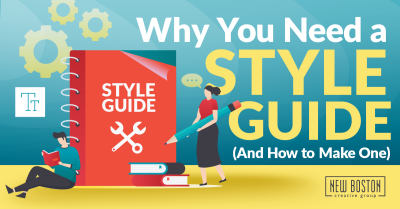Why You Need a Style Guide (And How to Make One)
by Sarah Caldwell Hancock on November 4, 2025
Picture it: You are writing something for your landscaping and nursery business — maybe a blog post about a new product line, a few social media posts about upcoming promotions or even a business letter to a vendor. You want your writing to be polished and consistent with what other members of your team have written (or even with other things you have written), and shoot, you can’t remember whether a certain product name has an internal capital letter (is it Plantmobile or PlantMobile?). Do you need to spell out the acronym for a certain type of fertilizer? Should you capitalize each word in a subhead, or only the first word?
This is why you need a style guide, which is a set of rules and guidelines that establish how your content should be written, formatted and designed so it’s as consistent and clear as possible. A style guide ensures that everyone who works for your company or organization knows the preferred tone and usage to adopt and the expectations they need to meet when writing content. Using a style guide will improve your content by making it more readable and credible by reducing or even eliminating errors. A style guide also will save time, because your team will know the main source to consult when they have questions.
One thing to note: A writing style guide is different from a brand guide, sometimes called a graphic standards guide, which is also important to have but focuses on visuals (logo, colors, fonts, etc.).
Bonus tip: Too busy to deal with making a style guide? You can use AI to help you develop one.
What goes in a style guide, and how do I make it?
Producing a style guide is a good-sized project, but you can break it up into a few simple steps.
1. Cover the basics. What are your core principles as a business or organization? Do you have a mission statement, vision, core values? Who is your target audience, and what should you sound like when you talk to them? Are you educational? Friendly? Authoritative? Putting these things in writing is important and helps everyone who generates content aim to meet the same goals. This section of the style guide doesn’t need to go on for several pages, but sketching it out at the beginning will help your team remember important guiding principles.
2. Pull together a list of tricky terms. In my landscaping business example, that would include PlantMobile, NPK fertilizer, some common plant names with difficult spellings, any specialized terms for tools or services your company uses regularly and so on.
3. Adopt an existing style manual as your baseline. This will save you a bunch of time, because the existing manual will outline basic grammar and punctuation rules, when you should use numerals instead of spelling numbers as words (for example, 1 vs. one), what needs a hyphen or when to use a dash or semicolon, whether to adopt the Oxford comma, and so on. Here at New Boston Creative Group, our baseline guide is the Associated Press (AP) Stylebook, which is widely used in journalism. Government organizations might use the Government Publishing Office (GPO) Style Manual, and formal or academic writers might use The Chicago Manual of Style or The Modern Language Association (MLA) Handbook. Social and behavioral sciences use the Publication Manual of the American Psychological Association, known as APA Style.
4. Develop your own list of changes or exceptions to your baseline guide’s rules. This will require you to spend a little time looking through your chosen guide.
- AI tip: Ask your AI chatbot of choice for a list of the most commonly used rules from the [insert name here] style guide. This will speed up your ability to read and digest a style guide and can help you decide which one to adopt if you’re on the fence. AI can also provide you a “cheat sheet” based on the style guide you choose.
- Exceptions: If you’re going to deviate from the baseline guide, make sure you note that change as an entry in your guide. At NBCG, for example, we prefer italicizing titles rather than placing them in quotes, which is a change from AP Style. Consequently, our style guide contains an entry for “titles — composition titles” that explains the difference and shows some examples.
- Note: If you’re going to use AP style or some other stylebook, you also might want to purchase a subscription to the online version of the guide or a physical copy of the book. Some style manuals are available online for free in the form of a searchable PDF. Or, if you use the AI tip above, you may be able to get away with a cheat sheet rather than the whole guide.
5. Continue to refine your guide. You won’t think of everything right off the bat, and that’s OK. Your style guide should evolve. (Even AP makes updates periodically!) Keep adding to or updating your guide as certain questions come up; this will ensure you and your team will be on the same page going forward. AI can help with this: After you’ve gotten started, go back to your chatbot of choice and ask it to help you tailor a writing guide for your business. Describe what you want, and be prepared to upload sample documents or direct it to your website to find text to provide an example. It can draft a basic template for you and help you refine it based on your audience and needs, and it can add what you’ve already developed. AI can help you generate additional entries for your guide, and if it comes up with items you don’t need, it’s easy enough to delete them.
6. Make your guide a sharable document. You can use a Google Doc or upload it to One Drive or use some other service, but the point is to make it a living document that more than one person can access at once. Also important:
- The guide should be available to all users in real time.
- Avoid version-control issues by using a file that doesn’t need to be downloaded and re-uploaded with each change. For example, don’t rely on a Word document that users can store locally, since this increases the risk of using outdated information.
- Format the document so it’s easy for users to scan (bolded entries with adequate spacing between them) and search.
You now have the beginnings of a style guide that can grow as it needs to. When you run across a commonly made mistake or a new term or formatting issue, simply add it to the guide.
USE IT!
Now your challenge is making sure everyone uses the style guide so your writing achieves the level of consistency and professionalism that led you to develop the guide in the first place. This might be a bigger challenge than creating the guide! Encourage everyone to get in the habit of looking things up as they write. One way to ensure style rules are followed is to follow an editing process in which the writer of a piece always asks for feedback from someone else. If you have someone on your team who is especially good at editing, you can appoint a single editor to check everyone’s work. Cover style guide use when you onboard new team members. You also can meet periodically, say every six months or year, to review changes and recurring errors with your team.
AI tip: If you don’t have an editor readily available, you could experiment with uploading your style guide and a piece of writing to your favorite AI chatbot and ask it to help you point out where the piece isn’t meeting style guidelines, or you could even develop a customized AI query or tool to accomplish this.
If you develop and use a style guide, you’ll see your communications improve over time. Want some help with a style guide or other communications project? We’re here for you!






